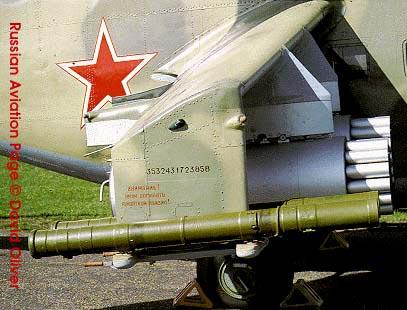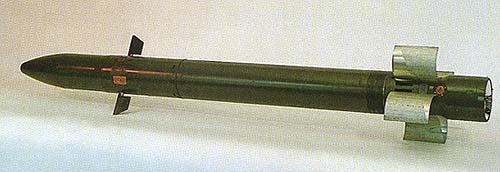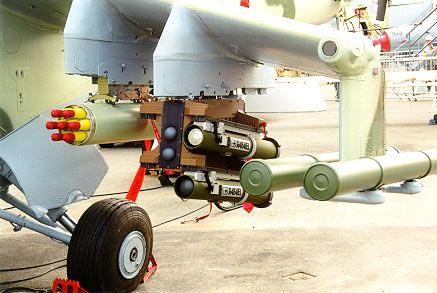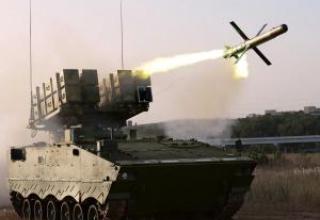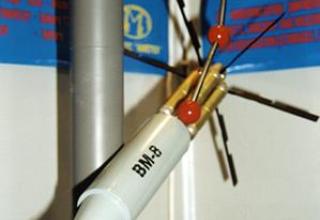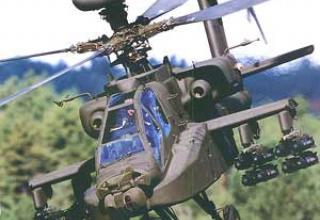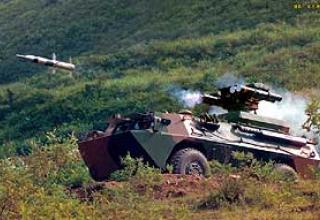The "Sturm-B" complex is designed to engage modern tanks, infantry fighting vehicles, PTUR and SAM launchers, long-term firing points such as DOT and DZOT, low-speed flying low-speed air targets, as well as enemy manpower in shelters.
The "Sturm-B" aircraft anti-tank missile system is based on the 9K114 "Sturm-S" ground self-propelled anti-tank system. Both systems use the same means of destruction - 9M114, 9M114M and 9M114F missiles. At present, the complex can also be equipped with advanced Ataka missiles - 9M120, 9M120F, 9A2200 and 9M2313.
Tests of the complex "Storm-B" was conducted on the Mi-24 helicopter from 1972 to 1974. The missile system was adopted on March 28, 1976 and became the main weapon of production helicopters Mi-24B (product 242). The developers have successfully solved a number of problems associated with the effects of vibrations, ensuring the combat application of missiles in flight of the helicopter at speeds up to 300 km / h. At a mass of equipment "Rainbow-SH". 224 kg helicopter "Storm" practically corresponded to "Falanga-PV" complex with "Rainbow-F" equipment. Despite the one-and-a-half times increase in the mass of the transport and launch container with the Sturm missile compared to the launching mass of the Falanga rocket, due to the simplification of the launcher and compactness of the TIC it was possible to double the ammunition of the carrier. On the Mi-24V helicopter was installed four missiles 9M114. In 1986, tested the Mi-24V helicopter with a new multilock beam holder, in the presence of which the helicopter can be installed up to 16 PTUR "Storm". Later, the complexes "Assault" were used in the armament of the Mi-24P (product 243), Mi-24PV (product 258), as well as Ka-29 helicopters - transport and combat version of the anti-submarine Ka-27. Rocket system "Assault" is equipped with a new combat helicopter Mi-28, which is installed up to 16 missiles on two launchers.
Ural Optical and Mechanical Plant together with Krasnogorsk plant and NPO "Geophysics" for mollerization of Mi-24V helicopters with PTUR "Sturm" created a new sighting station.
Ulan-Ude Aviation Plant has developed and is offering for export a new attack modification of Mi-8 transport and combat helicopter - Mi-8AMTSH helicopter with eight ATF "Storm" and four anti-aircraft missiles "Needle".
Based on the experience of the Sturm family of complexes, the Sturm ship complex with a range of up to 6 km is being developed for deployment on patrol boats of the 14310 project.
In the west, the missile was designated AT-6 "Spiral".
Composition:
The complex consists of:
- - Combat vehicles consisting of guidance and control equipment mounted on the helicopter;
- - guided missiles in transport and launch containers (TLCs);
- - maintenance equipment for bases and arsenals, consisting of guidance and control equipment for the carrier and control equipment for routine inspections of missiles;
- - training facilities, consisting of a simulator and missile training models.
Two-stage missile 9M114 (see description of the PTUR 9M114) of "Assault B" complex (all modifications) is made according to "duck" scheme. To reduce the weight and dimensions of the missile controls are made on a single-channel scheme. In flight, the rocket rotates relative to the longitudinal axis, and the aerodynamic rudders moved forward from the niches are placed in one plane. Control commands from the onboard control system are transmitted to the front bays by cables laid in a tube running along the longitudinal axis of the rocket inside the combustion chamber of the march solid fuel engine. Behind the two-nozzle engine block in the tail compartment, the main elements of the radio command control system are located. At the rear end of the march stage is a source of infrared radiation, fixed by helicopter semi-automatic control equipment, as well as a radio antenna. In the transport position, the tail compartment is covered by four wing consoles. The wings - rectangular in plan, when viewed from the front curved in an arch towards each other open spring mechanism. The plane of the aerodynamic rudders is shifted by 45 ° in relation to the planes of attachment of the wings and at 90 ° - to the plane of the nozzle axles. In the rear of the tube of the transport and launch container is placed launch accelerator - acceleration engine, which is separated from the rocket at the end of its work. The rocket is delivered from the manufacturing plant in a fiberglass transport and launch container (GRP). The design of the FRPC ensures that the missile rotates around its longitudinal axis during launch. The type of launch is from the TPK by means of an embossing charge. For the destruction of objects such as DOTs and DZOTs, living force of the enemy, a version of the missile 9M114F with a blast (thermobaric) combat unit.
Control and guidance equipment - optical sight with built-in direction finding channel, ballistic calculator, radio command communication equipment "Rainbow-SH". (field of view on the capture channel - 9°, field of view on the tracking channel - 2°, weight - 224 kg). After launching the missile, the helicopter can maneuver in the sector ± 60 °, with a roll up to 30 °.
Missile guidance system - semi-automatic, radio command, with infrared tracking signal. High noise immunity of the complex is provided by a narrow diagram of the direction of the radio antenna and the relative short duration of the cycle of radiation of radio equipment, as well as switching five litre frequencies and two remotely controlled codes of control signals. Thus, the possibility of simultaneous use of weapons by a group of up to 10 helicopters in limited airspace is provided. To exclude the capture of the direction finding helicopter equipment semi-automatic guidance "alien" rocket signal infrared radiator PTUR is formed in accordance with the frequency and code of the microwave pulse commands radio control, coming on board the missile. The direction finders for reception of a signal of infra-red radiator PTUR are built in sighting devices of helicopter or ground guidance equipment. At the maximum range of fire accuracy of the control system does not exceed 0.6 angular minutes. This allows to fire any small armored targets and even helicopters in hover and take-off mode. The maximum altitude of air targets (sea level launch) is 3000 meters.
As part of the "Assault Navigation" complex, the guidance of the missile is reduced to the following actions. After the detection of the target and the decision of the helicopter crew to launch a missile on it, the operator combines a fixed mark with the target and presses the button, selecting the corrected mode of program guidance to the target. Laser rangefinder in automatic mode measures the distance to the selected object, and presents the data on the multifunction display, along with information about the necessary maneuvers to bring the helicopter into the zone of acceptable launch. The pilot performs piloting of the helicopter so that the moving target mark remains in a fixed square. The operator at this time ensures that the fixed target mark is aligned with the target and, if necessary, makes adjustments by manipulating the control levers. When the helicopter reaches the allowable start zone, the digital computer sends the command "achievable" to the multifunction display ("start allowed"). On this command, the operator launches the missile. During the missile's flight, the operator holds a fixed mark on the multifunction display that is aligned with the target and, if necessary, aligns the position of the sighting line by manipulating the control levers until the target is hit.
Characteristics:
| Range of fire, m: - 9M114 missile - 9M120 |
5000 6000 |
| Average flight speed, m/s | 420-530 |
| Flying speed of the carrier, km/h | up to 300 |
| Medium maneuvering sector, deg | ±60° |
| Flight time at maximum range,s | 14.5 |
| Probability of hitting the target | 0.65-0.98 |
| Armor-piermeable, mm | 500-650 |
| Weight of combat unit, kg | 5.3-6 |
| The length of the rocket, mm | 1830-1840 |
| Maximum rocket body diameter, mm | 130 |
| Start weight , kg | 31.4 - 35.4 |
| Missile weight in TPK, kg | 46 -46.5 |
| Application temperature, °C | ±50°С |
Testing:
The complex was not exported and did not participate in hostilities.
In 1972 the complex underwent modernization, the task of which was to reduce the lower boundary of the kill zone and provide the possibility of firing at maneuvering targets and inhalation. After modernization the complex was named "Storm-M" and in the same year it was adopted for service. On Apr. 1134A and 1134B the "Grom-M" control system served not only the SAM system, but also the "Blizzard" anti-submarine system.
In 1980-1986, the system was upgraded to fire low-altitude anti-ship missiles. The SAM system was named "Storm-N" and the missile was named B-611M (4K65).
Sources:
- А.В.Карпенко, С.М. Ганин "Отечественные авиационные тактические ракеты", "Бастион" N1, 2000г.
- Р.Д.Ангельский "Отечественные противотанковые комплексы" -М: ООО "Издательство Астрель", 2002,-192с.
